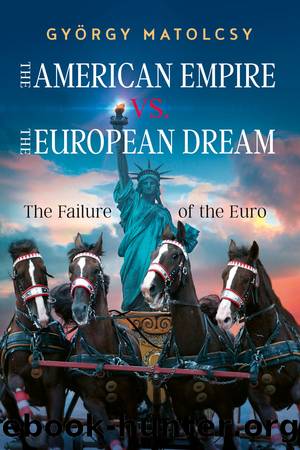The American Empire vs. The European Dream: The Failure of the Euro by György Matolcsy

Author:György Matolcsy [Matolcsy, György]
Language: eng
Format: epub
Tags: Business & Finance, Economics, Nonfiction, Social & Cultural Studies, Political Science, Government
ISBN: 9786155884610
Barnesnoble:
Publisher: PublishDrive
Published: 2019-11-28T00:00:00+00:00
AMERICAN INNOVATION
Thus, the American Empire learned from the British that to build and maintain an empire, the use of different means was required depending on the period of time, and the rivals concerned. Just as the British employed a variety of means to enforce their interests against the French, the Dutch, the Indians and the Americans themselves, present-day America is employing a variety of means to enforce its interests against its allies and rivals. The interests of the American World Empire can be promoted most effectively by political and military means in some cases, and through economic and financial warfare in others.
What has happened since 1971 in the global financial system is an American innovation. In the 1960s, America became aware that its rivals defeated in World War II, and indeed in the long BritishâGerman war, namely Germany and Japan, had regained their strength, and as a result of successful economic reconstruction and American assistance, were already more competitive than the American economy. Consequently, they were accumulating substantial trade surpluses vis-Ã -vis the American economy, which in turn they were keen to convert to gold. Since America was operating a financial system throughout the world in which the US dollar was freely convertible to gold while the prices of the two were pegged to each other, the Germans and the Japanese, accumulating increasing amounts of dollars, demanded increasing amounts of gold from the stocks of the American Fed.
In 1970 and early 1971, President Nixon made several attempts to persuade German and Japanese leaders to invest their trade surplus vis-Ã -vis America in American securities, that is, to reinvest their profits from their trade with America in the American economy. Sensing their strength, German and Japanese political leaders, in consultation with bankers, declined the offer. This was when American financial innovation entered the scene. Nixon discontinued the conversion of the US dollar to gold, and then abandoned the dollar peg. When the dust settled, conversion of the US dollar to gold was resumed, but at an exchange rate that was more favourable to America, without the dollar being pegged to other currencies. Since 1971, America has been adjusting the exchange rate of the dollar against other currencies in accordance with its prevailing economic and financial interests, skimming a major part of the profits from world trade. Additionally, America has been printing new money continuously and in increasing quantities, given the demand of a growing world trade for increasing quantities of money, while the status of the dollar as a world currency also means that America is supplying the world with the amount of dollars needed for trade.
These, along with a number of other economic and financial means, are financial innovations that the American Empire has been using on a global scale to promote its own interests. Underlying these means is the understanding obtained from the British schoolmaster that in order to overcome its rivals, an empire needs to follow a versatile strategy that is not merely comprised of political and military means.
Download
This site does not store any files on its server. We only index and link to content provided by other sites. Please contact the content providers to delete copyright contents if any and email us, we'll remove relevant links or contents immediately.
Zero to IPO: Over $1 Trillion of Actionable Advice from the World's Most Successful Entrepreneurs by Frederic Kerrest(4060)
Machine Learning at Scale with H2O by Gregory Keys | David Whiting(3637)
Harry Potter and the Goblet Of Fire by J.K. Rowling(3612)
Never by Ken Follett(3531)
Ogilvy on Advertising by David Ogilvy(3337)
Shadow of Night by Deborah Harkness(3177)
The Man Who Died Twice by Richard Osman(2810)
Book of Life by Deborah Harkness(2721)
My Brilliant Friend by Elena Ferrante(2704)
How Proust Can Change Your Life by Alain De Botton(2615)
0041152001443424520 .pdf by Unknown(2599)
Will by Will Smith(2581)
The Tipping Point by Malcolm Gladwell(2562)
How to Pay Zero Taxes, 2018 by Jeff A. Schnepper(2500)
Purple Hibiscus by Chimamanda Ngozi Adichie(2490)
Hooked: A Dark, Contemporary Romance (Never After Series) by Emily McIntire(2423)
Rationality by Steven Pinker(2150)
Borders by unknow(2119)
Daughter of Smoke and Bone by Laini Taylor(2082)
